Printing diagrams
The Print window allows you to preview the printout and to execute print jobs. I also comes with a set of options for you to configure the printout. To open the Print window, select Project > Print from the application toolbar.
An overview of Print window
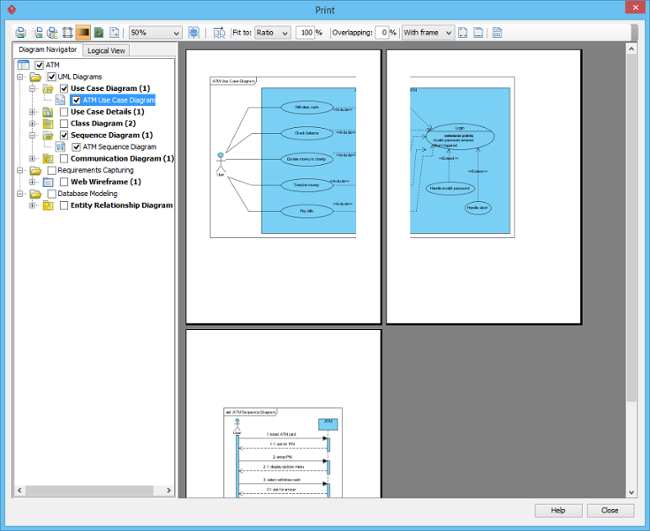 |
| The Print window |
The toolbar of the print preview pane allows you to configure the print settings. The buttons and their descriptions are shown in the table below:
|
||||||||||||||||||||||||||||||||||||||||||||||||||||||
| Details of toolbar |
Printing a diagram with preview
You can use the Print command to select the printer. Set the range of pages and number of copies to be printed.
- Select the desired diagram(s) for printing. The selected diagram(s) will be shown in the preview area.
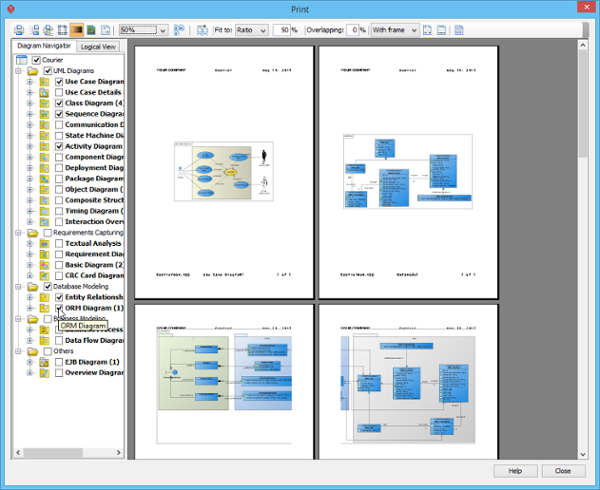
Diagram preview - Click the Print button
 on the Print preview toolbar. The Print window will be shown.
on the Print preview toolbar. The Print window will be shown.
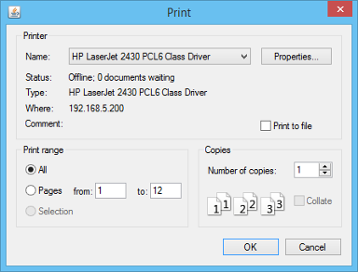
The Print window - Select a specific printer, the page range and the number of copies to be printed. You may click the Properties... button to configure the printer-specific properties as well.
- Click OK to start printing.
Page setup
Page Setup allows you to specify the page size, orientation, as well as the margins of the pages.
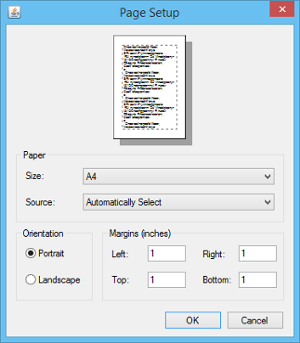 |
| The Page setup window |
- Click the Page Setup button
 on the toolbar. The Page Setup window will appear.
on the toolbar. The Page Setup window will appear. - You can click the Size drop-down menu to select the paper size for printing.
- You can check either Portrait or Landscape udner Orientation.
- You can enter the value into the Left, Right, Top and Bottom text fields to adjust the size of the corresponding margin.
- Click OK to confirm the settings.
Adjusting margins
The Margins pane allows user to specify the margins of the pages, header and footer.
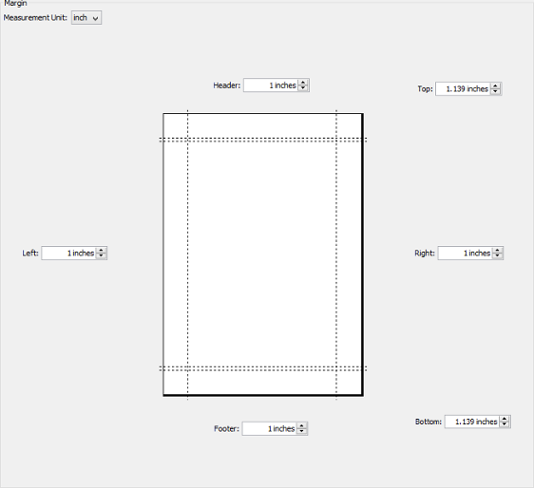 |
| Adjusting margins |
1. Click the Adjust Margin button ![]() on the toolbar. The margin setting page will be shown in the preview area.
on the toolbar. The margin setting page will be shown in the preview area.
2. You can edit the margins size by entering the sizes into the text fields. Alternatively, click the spinner buttons to increase/ decrease the margin sizes.
3. Click the Finish Adjust Margin button ![]() when you finish configuring the margin settings. The margin sizes will then be updated.
when you finish configuring the margin settings. The margin sizes will then be updated.
Zooming pages
Diagrams can be zoomed in or zoomed out according to the user's preference.
- Click the Zoom drop-down menu to select the desired zoom ratio.
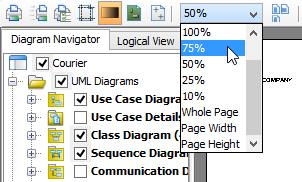
Set zoom ratio - The preview area will show the diagrams in the zoom ratio that you have selected.
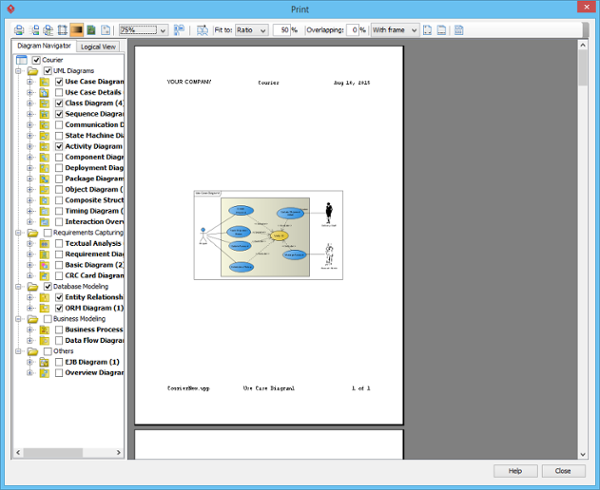
Previewing printout
Selecting the preview layout
There are two layouts that you can choose for the print preview, the Paper Base Layout and the Diagram Base Layout.
If the Fit to Pages option is chosen and there are multiple pages in the printout, choosing Paper Base Layout will cause the distribution of pages to be paper-oriented (the diagram size is ignored in arranging the preview); while choosing Diagram Base Layout will cause the distribution of pages to be diagram-oriented.
Note that this option affects the preview only; the order of the printout remains unchanged.
To select a layout of the preview, click the Paper Base Layout button ![]() or Diagram Base Layout button
or Diagram Base Layout button ![]() on the toolbar. A pop-up menu where you can choose the layout will appear.
on the toolbar. A pop-up menu where you can choose the layout will appear.
The preview after applying the Paper Base Layout:
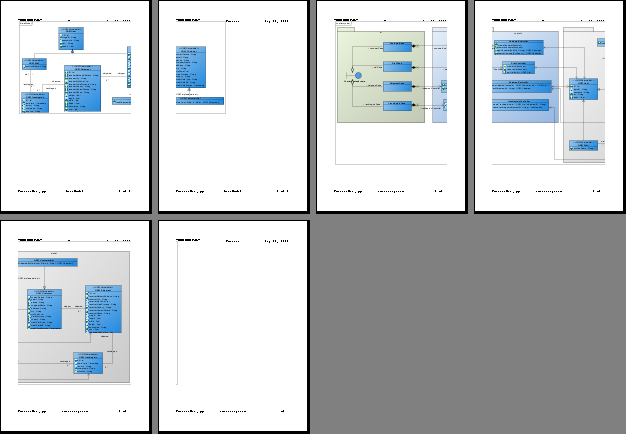 |
| Preview in paper base layout |
The preview after applying the Diagram Base Layout:
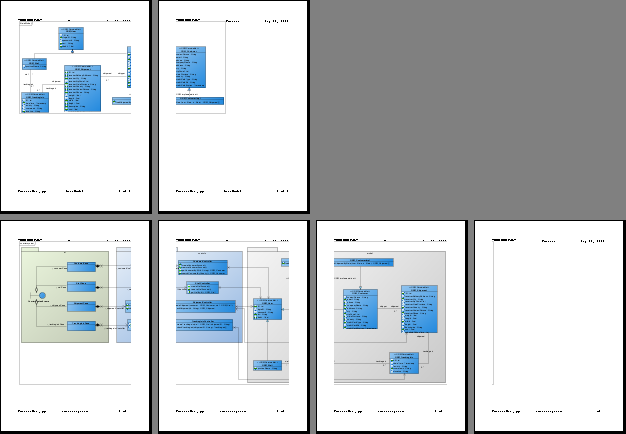 |
| Preview in diagram base layout |
Setting paper place style
You can select the paper place style to change the order of the printout. To select the paper place style, click the Paper Place Style button on the toolbar. A pop-up menu where you can choose a paper place style will appear.
Considering a large diagram is divided into many pages, choose From left to right will arrange the printout order from the pages on the left to the pages on the right, while choosing From top to bottom will arrange the print order from the pages on the top to the pages on the bottom.
The order of the printout after choosing From left to right:
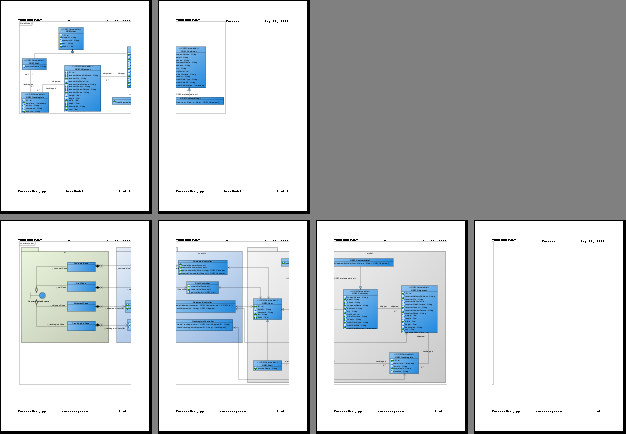 |
| Printout order is left to right |
Fit to ratio
Fit to Ratio is used to resize the diagrams in the printout to a specific ratio.
Click the Fit to drop-down menu and select Ratio.
You can enter the ratio into the text field. After editing the ratio, the diagrams in the printout will be resized at once.
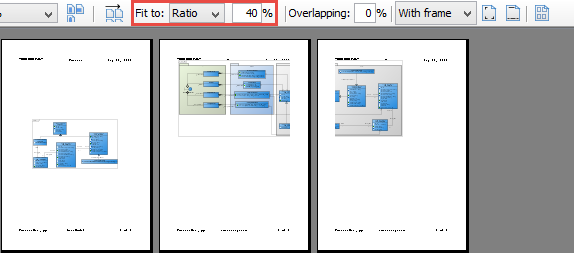 |
| Fit to ratio |
Fit to pages
Fit to Pages is used to split the diagram to a desired number of pages when printing.
- Click the Fit to drop-down menu and select pages.
- Click the Multiple Page Mode button
 on the toolbar. The page selector will appear.
on the toolbar. The page selector will appear.
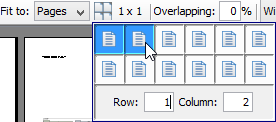
Select multiple pages - Click the row-column combination to select it (note that you can click and drag on the page selector to extend the selection). The diagram will be split into multiple pages by the rows and columns that you have selected.
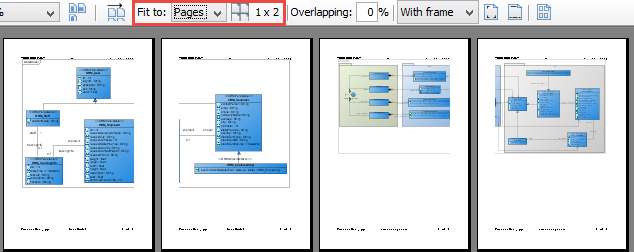
Fit to page
Setting the diagram overlap percentage
Overlapping is used when users want the diagrams to be overlapped at the boundaries between pages. This is particularly useful when you have a large diagram that span multiple pages and you want to stick the pages of the printout together; the overlapping area can then be used as a hint when sticking the pages.
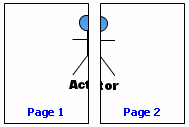 |
| Multiple page without overlap |
- Input the overlapping percentage and press Enter in Overlapping text field.
- The printing area near the boundaries of the pages will be duplicated through the input value of overlapping percentage.
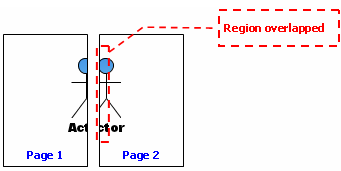 |
| Multiple page with overlap |
Printing with frame/Border option
You can print your diagram with a frame or border. There are three options available:
- With frame
- With border
- No border
Select With frame/ With border/No border option from the drop-down menu.
 |
| Select an option from drop-down menu |
Output of printing with frame:
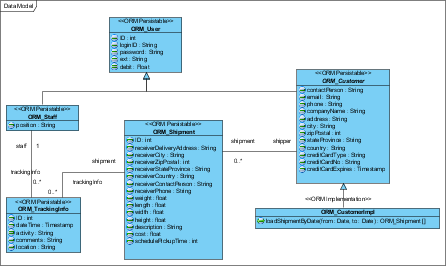 |
| Printing with frame |
Output of printing with border:
 |
| Printing with border |
Output of printing with no border:
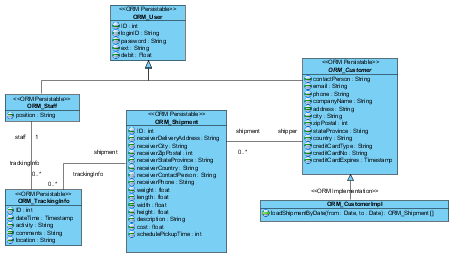 |
| Printing with no border |
Showing/Hiding clip marks on page
Clip marks act as an indication of the boundary of a page.
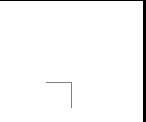 |
| Clip marks |
To show clip marks on the printout, click the Show Clip Marks on Page button ![]() . The boundaries of the pages will be surrounded by clip marks. To hide the clip marks, click the Hide Clip Marks on Page button
. The boundaries of the pages will be surrounded by clip marks. To hide the clip marks, click the Hide Clip Marks on Page button ![]() again.
again.
Editing header/footer of the pages
To edit the header/ footer of the printout, click the Edit Header/Footer button ![]() on the toolbar. You will then switch to the edit header/footer pane.
on the toolbar. You will then switch to the edit header/footer pane.
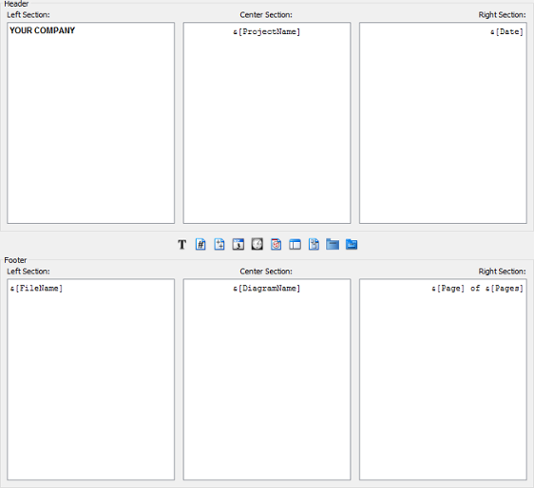 |
| Editing header/footer of pages |
You can edit the header and the footer in the Header panel and the Footer panel respectively. Each of the panel consists of the Left Section, Center Section and the Right Section, which represents the position that the content will be located in the header/footer.
There is a toolbar between the Header panel and the Footer panel, which facilitates the editing of header/footer. The description of the buttons in the toolbar can be found in the following table:
|
|||||||||||||||||||||||||||||||||
| The description of editing of header/ footer toolbar |
After you have finished editing the header/footer, click the Close Edit Header/Footer button ![]() to switch to the print preview mode. A sample page with the header and footer is shown in the figure below:
to switch to the print preview mode. A sample page with the header and footer is shown in the figure below:
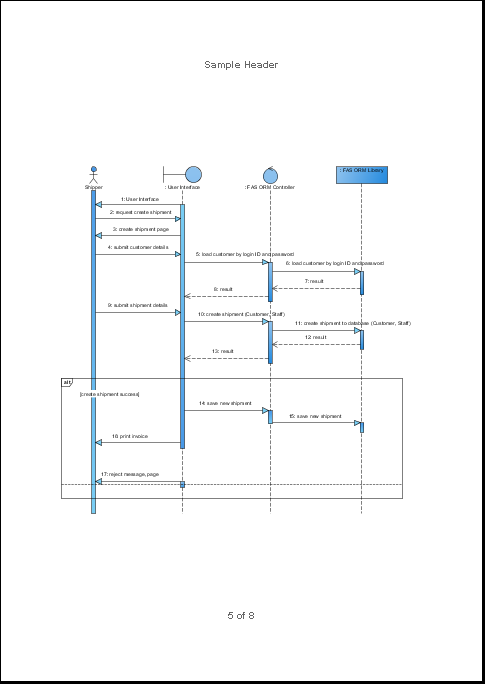 |
| Page with header and footer |
The multiple page mode
The Multiple Page Mode allows users to configure how the diagrams should be distributed in multiple pages. To switch to the Multiple Page Mode, click the Multiple Page Mode button ![]() on the toolbar.
on the toolbar.
Click the icon behind Multiple Pages will pop the page selector out, where you can select the row-column combination for the printout. Alternatively, you can type in the Row and Column text field directly.
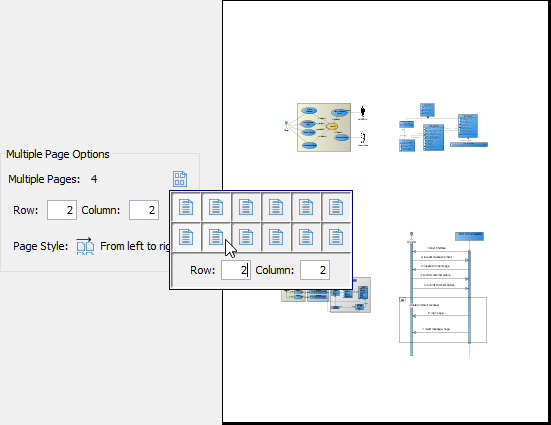 |
| Select multiple pages |
Click the icon behind Page Style to change the printout order. Considering a large diagram is divided into many pages, choosing From left to right will arrange the printout order from the pages on the left to the pages on the right, while choosing From top to bottom will arrange the print order from the pages on the top to the pages on the bottom.
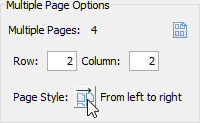 |
| Distributes diagram in multiple page |
After you have finished configuring the multiple page settings, click the Close Multiple Page Mode button to close it.
Related Resources
The following resources may help you to learn more about the topic discussed in this page.
| Chapter 16. Printing diagrams | Table of Contents | 2. Quick print |
